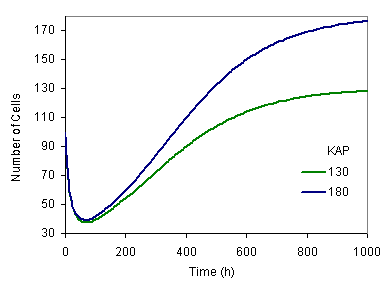
 | ||||||
| Tutorial#13: The use of KAP and VOL parameters How to set up DSB formation and repair models |
KAP, the peak cell density and VOL, the effective volume of the cell culture or the tissue region of interest determines the bounding conditions of cell multiplication. |
Example 13.1 Time variation of the cell count after a multi-fraction exposure for different choices of the peak cell density (rmrsim6.inp -> rmrsim6.out, rmrsim7.inp -> rmrsim7.out).  Cell count after multi-fraction dose exposure for different values of the peak cell density, KAP. Comments: Cell count after multi-fraction dose exposure for different values of the peak cell density, KAP. Comments:
Tip: Experiment by changing the various model parameters and physically interpreting your results. |
| School of Health Sciences Purdue University Disclaimer | Last updated: 10 June, 2011 |